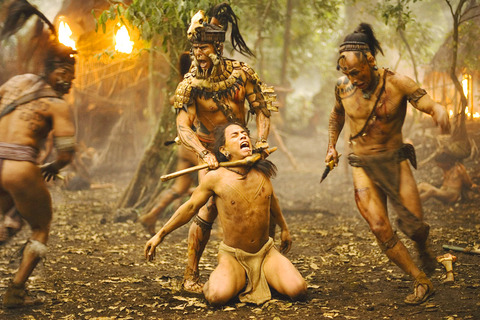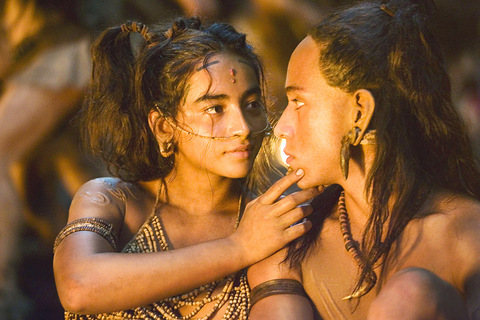"I'm going to peel off his skin and make him watch me wear it." This grisly threat is delivered by one of the main bad guys in Mel Gibson's Apocalypto. The promised flaying never takes place, but viewers who share this director's apparently limitless appetite for gore will not be disappointed, since not much else in the way of bodily torment has been left to the imagination. There are plenty of disembowelings, impalings, clubbings and beheadings. Hearts are torn, still beating, from slashed-open chests. A man's face is chewed off by a jaguar. Another's neck is pierced by darts tipped with frog venom. Most disturbing, perhaps, is the sight of hundreds of corpses haphazardly layered in an open pit: a provocative and ill-advised excursion into Holocaust imagery on this director's part.
Violence has become the central axiom in Gibson's practice as a filmmaker, his major theme and also his chief aesthetic interest. The brutality in Apocalypto is so relentless and extreme that it sometimes moves beyond horror into a kind of grotesque comedy, but to dismiss it as excessive or gratuitous would be to underestimate Gibson's seriousness. And say what you will about him — about his problem with booze or his problem with Jews — he is a serious filmmaker.
Which is not to say that Apocalypto is a great film, or even that it can be taken quite as seriously as it wants to be. Gibson's technical command has never been surer; for most of its 138-minute running time, Apocalypto, written by Gibson and Farhad Safinia, is a model of narrative economy, moving nimbly forward and telling its tale with clarity and force. It is, above all, a muscular and kinetic action movie, a drama of rescue and revenge with very little organic relation to its historical setting. Yes, the dialogue is in various Mayan dialects, which will sound at least as strange to American ears as the Latin and Aramaic of The Passion of the Christ, but the film's real language is Hollywood's, and Gibson's, native tongue.

When I first heard about this project, and later when I saw the early trailers, I halfway hoped that Gibson might turn out to be an American (or half-Australian) version of Werner Herzog, setting out into the jungle to explore the dark and tangled regions of human nature. Once you get past the costumes and the subtitles, though, the most striking thing about Apocalypto is how comfortably it sits within the conventions of mainstream moviemaking. It is not an obsessive opera like Herzog's Aguirre: The Wrath of God, but rather a pop period epic in the manner of Gladiator or Braveheart, and as such less interested in historical or cultural authenticity than in imposing an accessible scheme on a faraway time and place.
The setting is Central America before the arrival of the Spanish, when the Maya empire, in Gibson's version, was already in the process of collapsing from within. The basic moral conflict — as it was in Braveheart, directed by and starring Gibson, and in The Patriot, a vehicle for him directed by Roland Emmerich — is between a small group of people trying to live simple, decent, traditional lives and a larger, more powerful political entity driven by bloodlust and greed. This kind of conservative anti-imperialism runs consistently through Gibson's work; whether the empire in question is Roman, British or Mesoamerican, and whatever its political resonance might be, it allows the viewer to root for an unambiguously virtuous underdog.
Apocalypto begins with a group of young men out on a hunt and lingers for a while in their happy, earthy village, a place that might double as a nostalgic vision of small-town America were it not for the loin cloths, the tattooed buttocks and the facial piercings. Blunted (Jonathan Brewer) is nagged by his mother-in-law and teased by his buddies because he hasn't yet made his wife pregnant, but he accepts his humiliation in good humor, like the jolly fat kid on a family sitcom.

PHOTOS COURTESY OF FOX
Meanwhile Jaguar Paw (Rudy Youngblood), whose father (Morris Birdyellowhead) is an admired hunter and warrior, snuggles down with his pregnant wife, Seven (Dalia Hernandez), and their young son, Turtle Run (Carlos Emilio Baez). There's fresh tapir meat on the grill and an old-timer telling stories by the fire. Life is good.
Needless to say, this pastoral idyll cannot last. The ominous strains of James Horner's score indicate as much. Before long the village is set upon by fearsome marauders, led by Zero Wolf (Raoul Trujillo), who rape, burn and kill with ruthless discipline and undisguised glee. The locals resist valiantly, but the survivors are led away to an uncertain fate. Seven and Turtle Run stay behind, hidden in a hole in the ground.
Jaguar Paw's mission will be to rescue them and also to avenge his friends and kin. First, though, he will accompany us on a Cecil B. DeMille tour of the decadent imperial capital, a place of misery, luxury and corruption, where priests and nobles try to keep famine and pestilence at bay with round-the-clock human sacrifices.
Neither Gibson's fans nor his detractors are likely to accuse him of excessive subtlety, and the effectiveness of Apocalypto is inseparable from its crudity. But the blunt characterizations and the emphatic emotional cues are also evidence of the director's skill.
Perhaps because he is aiming for an audience wary of subtitles, Gibson rarely uses dialogue as a means of exposition, and he proves himself to be an able, if not always terribly original, visual storyteller. He is not afraid of cliche — the slow-motion, head-on sprint toward the camera; the leap from the waterfall into the river below — but he executes them with a showman's maniacal relish.
And it is, all in all, a pretty good show. There is a tendency, at least among journalists, to take Gibson as either a monster or a genius, a false choice that he frequently seems intent on encouraging. Is he a madman or a visionary? Should he be shunned or embraced? Censured or forgiven?
These are the wrong questions, but their persistence reveals the truth about this shrewd and bloody-minded filmmaker. He is an entertainer. He will be publicized, and he will be paid.

One of the biggest sore spots in Taiwan’s historical friendship with the US came in 1979 when US president Jimmy Carter broke off formal diplomatic relations with Taiwan’s Republic of China (ROC) government so that the US could establish relations with the People’s Republic of China (PRC). Taiwan’s derecognition came purely at China’s insistence, and the US took the deal. Retired American diplomat John Tkacik, who for almost decade surrounding that schism, from 1974 to 1982, worked in embassies in Taipei and Beijing and at the Taiwan Desk in Washington DC, recently argued in the Taipei Times that “President Carter’s derecognition

This year will go down in the history books. Taiwan faces enormous turmoil and uncertainty in the coming months. Which political parties are in a good position to handle big changes? All of the main parties are beset with challenges. Taking stock, this column examined the Taiwan People’s Party (TPP) (“Huang Kuo-chang’s choking the life out of the TPP,” May 28, page 12), the Democratic Progressive Party (DPP) (“Challenges amid choppy waters for the DPP,” June 14, page 12) and the Chinese Nationalist Party (KMT) (“KMT struggles to seize opportunities as ‘interesting times’ loom,” June 20, page 11). Times like these can

Dr. Y. Tony Yang, Associate Dean of Health Policy and Population Science at George Washington University, argued last week in a piece for the Taipei Times about former president Ma Ying-jeou (馬英九) leading a student delegation to the People’s Republic of China (PRC) that, “The real question is not whether Ma’s visit helps or hurts Taiwan — it is why Taiwan lacks a sophisticated, multi-track approach to one of the most complex geopolitical relationships in the world” (“Ma’s Visit, DPP’s Blind Spot,” June 18, page 8). Yang contends that the Democratic Progressive Party (DPP) has a blind spot: “By treating any

You can tell a lot about a generation from the contents of their cool box: nowadays the barbecue ice bucket is likely to be filled with hard seltzers, non-alcoholic beers and fluorescent BuzzBallz — a particular favorite among Gen Z. Two decades ago, it was WKD, Bacardi Breezers and the odd Smirnoff Ice bobbing in a puddle of melted ice. And while nostalgia may have brought back some alcopops, the new wave of ready-to-drink (RTD) options look and taste noticeably different. It is not just the drinks that have changed, but drinking habits too, driven in part by more health-conscious consumers and